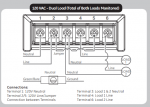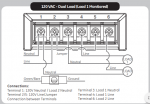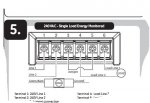- May 22, 2016
- 39
- Pool Size
- 15000
- Surface
- Plaster
- Chlorine
- Salt Water Generator
- SWG Type
- CircuPool RJ-45 Plus
Hey Folks,
My pump timer (Intermatic T104P) stopped working, resulting in me having to manually turn it on/off. I decided to replace it with the GE Smart Z-Wave 40-Amp Switch so I could get into automation. The pump is configured for 220 and fed by two 20 amp breakers with a neutral wire (4 wires coming into timer box - ground, line 1, line 2, neutral) at the sub panel near the pump assembly. NOTE: I have turned off all breakers both at the main panel and the sub panel as I took the old timer out. I'm, seeing if I can do this without shelling out for an electrician.
My problem is I'm not sure what to do with the neutral wire given that the pump only provides Load 1, Load 2, and the ground. There was no neutral connected to the pump with the old timer. Here are the two configurations in the Z Wave manual, not sure which to do and where to run the neutral (I've included the old t104 wiring schematic too where the neutral attaches to terminal A).
Thoughts on how to make this connection?
Thanks! Mike
T104 schematic

Z-Wave Dual Load 120 VAC Schematic (both loads monitored)

Z-Wave Dual Load 120 VAC Schematic (Load 1 monitored)

My pump timer (Intermatic T104P) stopped working, resulting in me having to manually turn it on/off. I decided to replace it with the GE Smart Z-Wave 40-Amp Switch so I could get into automation. The pump is configured for 220 and fed by two 20 amp breakers with a neutral wire (4 wires coming into timer box - ground, line 1, line 2, neutral) at the sub panel near the pump assembly. NOTE: I have turned off all breakers both at the main panel and the sub panel as I took the old timer out. I'm, seeing if I can do this without shelling out for an electrician.
My problem is I'm not sure what to do with the neutral wire given that the pump only provides Load 1, Load 2, and the ground. There was no neutral connected to the pump with the old timer. Here are the two configurations in the Z Wave manual, not sure which to do and where to run the neutral (I've included the old t104 wiring schematic too where the neutral attaches to terminal A).
Thoughts on how to make this connection?
Thanks! Mike
T104 schematic

Z-Wave Dual Load 120 VAC Schematic (both loads monitored)

Z-Wave Dual Load 120 VAC Schematic (Load 1 monitored)





